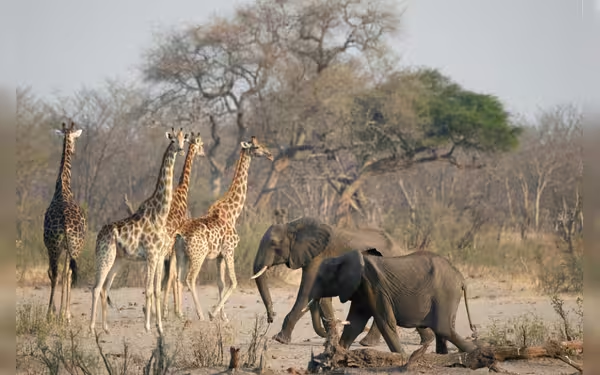Sunday, November 17, 2024 12:15 AM
Zimbabwe Plans Elephant Culling Amid Severe Drought
- Zimbabwe to cull 200 elephants for drought relief.
- Drought affects 68 million people in southern Africa.
- First culling since 1988 to manage wildlife population.
 Image Credits: arabnewspk
Image Credits: arabnewspkZimbabwe plans to cull 200 elephants to provide meat for communities affected by the worst drought in four decades, impacting millions.
Zimbabwe is facing a significant challenge as it grapples with the worst drought in four decades, a situation that has left many communities hungry and in dire need of food. In response to this crisis, the Zimbabwe Parks and Wildlife Authority has announced plans to cull 200 elephants. This decision comes as a measure to provide meat to those affected by the drought, which has severely impacted crops and food supplies across southern Africa, leaving approximately 68 million people in need of assistance.
The drought, driven by the El Nino weather phenomenon, has wreaked havoc on agriculture in the region. Tinashe Farawo, the spokesperson for Zimparks, confirmed the culling plan, stating, "We can confirm that we are planning to cull about 200 elephants across the country. We are working on modalities on how we are going to do it." The elephant meat will be distributed to communities suffering from food shortages, aiming to alleviate some of the hunger caused by the ongoing drought.
This culling marks the first time Zimbabwe has taken such action since 1988. The targeted areas for the cull include Hwange, Mbire, Tsholotsho, and Chiredzi districts. This decision follows a similar move by neighboring Namibia, which recently culled 83 elephants to provide meat to its drought-affected population.
Zimbabwe is home to one of the largest elephant populations in the world, with over 200,000 elephants estimated to inhabit a conservation area that spans five southern African countries: Zimbabwe, Zambia, Botswana, Angola, and Namibia. However, the country's parks can only sustainably support around 55,000 elephants. Farawo explained, "It’s an effort to decongest the parks in the face of drought. The numbers are just a drop in the ocean because we are talking of 200 (elephants) and we are sitting on plus 84,000, which is big." This indicates that while the culling may seem drastic, it is part of a broader strategy to manage wildlife populations effectively.
As the drought continues, the risk of human-wildlife conflict increases. Last year, Zimbabwe experienced tragic incidents, losing 50 people to elephant attacks. This highlights the delicate balance between wildlife conservation and the needs of local communities. Zimbabwe has been recognized for its conservation efforts and has been advocating for the reopening of trade in ivory and live elephants through the UN’s Convention on International Trade in Endangered Species (CITES). Currently, the country holds about $600,000 worth of ivory stockpiles that it is unable to sell.
While the culling of elephants may seem controversial, it is a necessary step in addressing the immediate needs of communities suffering from hunger due to the drought. It raises important questions about wildlife management, conservation, and the impact of climate change on both people and animals. As Zimbabwe navigates this challenging situation, it is crucial to find a balance that ensures the survival of both its wildlife and its people.













